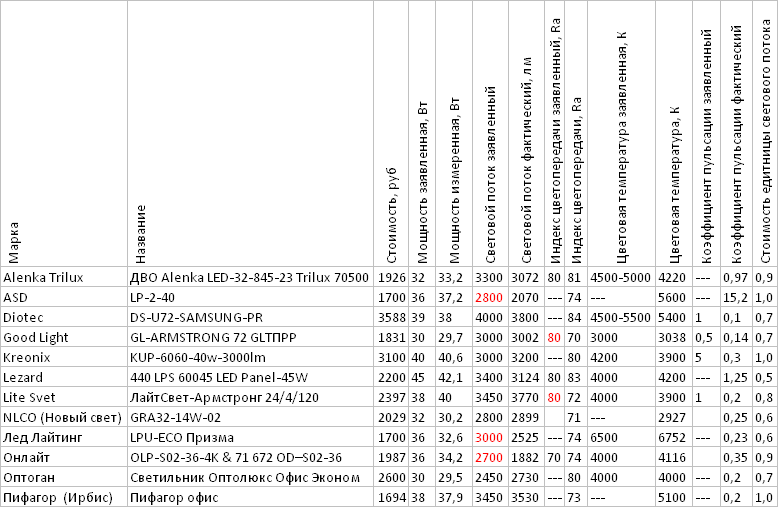Quality control of LED lamps and fixtures
The Svetotekhnika magazine conducted an independent quality check of LED lamps, office lamps, housing and public utilities lamps, industrial and street lamps.

The test results of LED lamps are depressing:
"9 out of 64 (14%) fully comply with the stated parameters."
"Manufacturers of 53 out of 63 lamps (84%) are misleading the consumer, indicating a clearly overestimated power equivalent to the LN flux."
"28 out of 64 lamps (44%) had a luminous flux of less than 90% of the declared."
To check the quality, 64 LED lamps with an E27 socket, 5 LED lamps for housing and communal services, 14 office LED lamps, 2 industrial lamps and 4 street lamps were purchased.
Testing was conducted in accredited laboratories of Russia and Belarus.
I will give a fragment of the table of test results for LED lamps (I removed the luminous efficiency column (Lm / W) and power factor from the original table. They can be found in the journal at the link I will give at the end of this article).

Red marked those declared values that are very different from the measured.
Many are interested in the quality of office LED lamps, replacing the lamps on fluorescent lamps. During the quality assessment, 14 such fixtures were tested:

LED lighting is very promising, and the sale of LED lamps is becoming more and more popular. That is why many unscrupulous manufacturers have rushed into this business. The lack of quality control by government agencies has led to what we have now.
Many buyers are disappointed in the LED lamps, buying the products of one of these manufacturers, despite the fact that there are already many high-quality lamps on the market that give light that is not inferior to incandescent lamps.
Now in GOST R 54815-2011 "LED lamps with built-in control device for general lighting for voltages above 50 V."There is only one important requirement: the measured initial luminous flux of the lamp must be at least 90% of the nominal luminous flux. But this requirement is not met in 28 of 64 tested lamps.
It is very important that minimum requirements for light pulsation, color rendering index and color temperature deviation are added to this GOST. More importantly, the requirements of GOST complied with.
Fully report on the implementation of the project "Conducting an independent test of the quality of lighting products" posted on the website of the journal Lighting .

The test results of LED lamps are depressing:
"9 out of 64 (14%) fully comply with the stated parameters."
"Manufacturers of 53 out of 63 lamps (84%) are misleading the consumer, indicating a clearly overestimated power equivalent to the LN flux."
"28 out of 64 lamps (44%) had a luminous flux of less than 90% of the declared."
To check the quality, 64 LED lamps with an E27 socket, 5 LED lamps for housing and communal services, 14 office LED lamps, 2 industrial lamps and 4 street lamps were purchased.
Testing was conducted in accredited laboratories of Russia and Belarus.
I will give a fragment of the table of test results for LED lamps (I removed the luminous efficiency column (Lm / W) and power factor from the original table. They can be found in the journal at the link I will give at the end of this article).

Red marked those declared values that are very different from the measured.
Many are interested in the quality of office LED lamps, replacing the lamps on fluorescent lamps. During the quality assessment, 14 such fixtures were tested:

LED lighting is very promising, and the sale of LED lamps is becoming more and more popular. That is why many unscrupulous manufacturers have rushed into this business. The lack of quality control by government agencies has led to what we have now.
Many buyers are disappointed in the LED lamps, buying the products of one of these manufacturers, despite the fact that there are already many high-quality lamps on the market that give light that is not inferior to incandescent lamps.
Now in GOST R 54815-2011 "LED lamps with built-in control device for general lighting for voltages above 50 V."There is only one important requirement: the measured initial luminous flux of the lamp must be at least 90% of the nominal luminous flux. But this requirement is not met in 28 of 64 tested lamps.
It is very important that minimum requirements for light pulsation, color rendering index and color temperature deviation are added to this GOST. More importantly, the requirements of GOST complied with.
Fully report on the implementation of the project "Conducting an independent test of the quality of lighting products" posted on the website of the journal Lighting .
